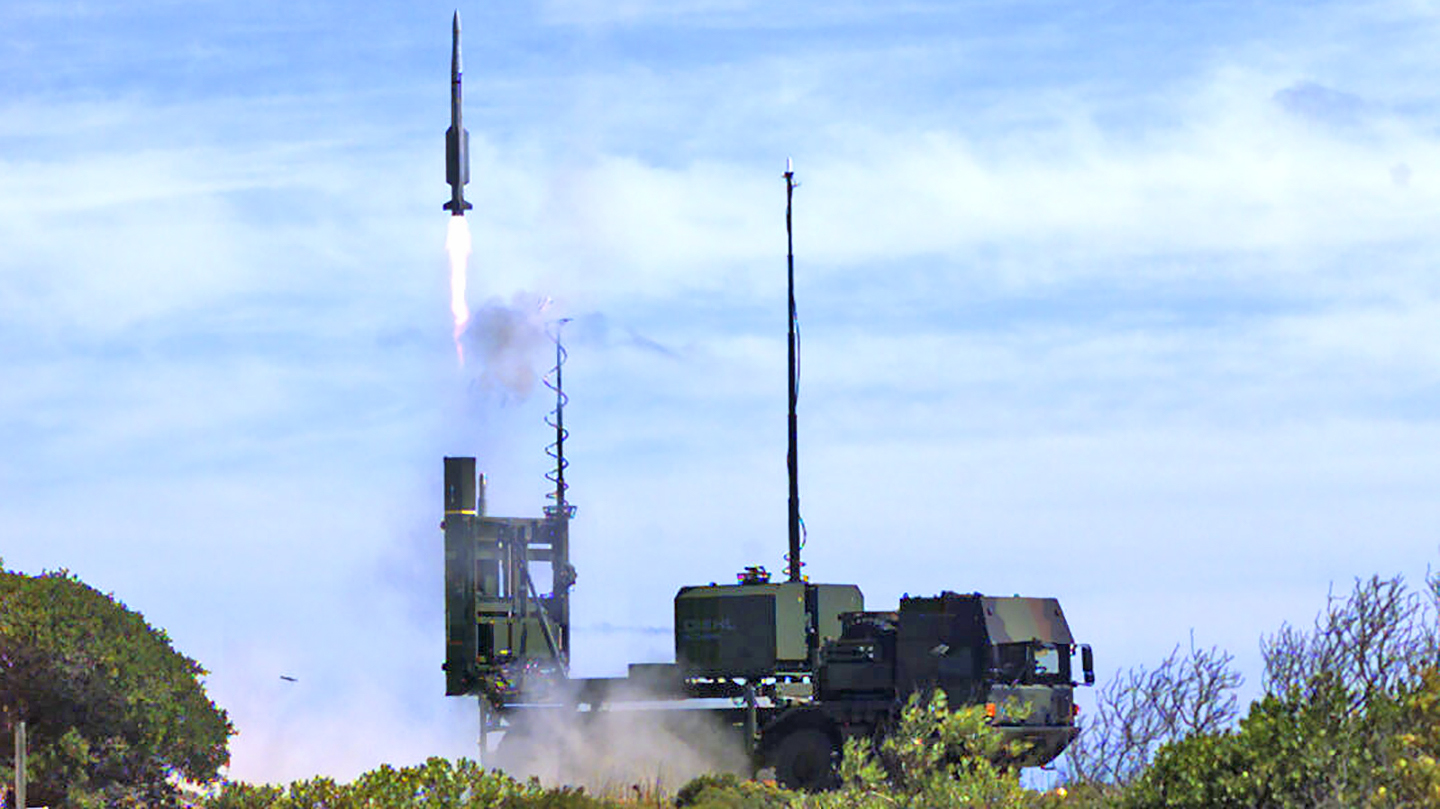Reports emerged today that Ukraine could receive the German-made IRIS-T SLM surface-to-air missile system by November. The Ukrainian government has also expressed interest in acquiring more of these SAM systems over the coming years.
According to Reuters and the German daily newspaper Bild, Germany is currently mulling over whether to send the system to Ukraine. Its manufacturer, Diehl Defence, claims the IRIS-T SL guided missile at the heart of the system can hit targets up to 25 miles away at altitudes of up to more than 12 miles. That would add much-needed capabilities to an aging Soviet-era air defense arsenal Ukraine has already used to great effect to prevent Russia from achieving air surpuriority.

That missile, according to Diehl Defence, is based on its previously developed and widely deployed IRIS-T air-to-air guided missile. The company claims that “selective adaptations,” including a streamlined nose section, give it its enhanced range and altitude capabilities. Its thrust-vectoring control “enables maximum lateral acceleration directly after launch, thus allowing engagements of targets at very short range” as well. It has an imaging infrared (IIR) seeker that allows for “high-precision terminal approach with extraordinary direct hit probability.” There is also a simpler SAM system that uses the standard IRIS-T missile called the IRIS-T SLS which has more limited capabilities. As it sits now, the more advanced IRIS-T SLM is the system being eyed to equip Ukraine’s air defenders.

The truck-mounted system has a multifunction radar, the ability to track multiple targets at once, and is designed to hit strategic bombers, fighter aircraft, attack helicopters, anti-radiation missiles, cruise missiles, guided bombs, drones, and large-caliber rockets. The missile is directed towards its target via a datalink. Once in close proximity, its imaging infrared seeker then acquires the target for the terminal phase of the engagement. Seeing as the missile itself has no active radar seeker, it cannot be jammed or confused by chaff and will not give direct warning of its approach via radar emissions. The fire control radar could potentially be detected though, or the missile could be guided to the general area of its target via a third-party sensor.

Reuters on Friday said that “a security source” said Germany was considering selling Ukraine the system. Earlier Friday, Bild reported that the German cabinet’s security council was “discussing the matter” and that the system could be deployed in Ukraine by November.
Ukrainian troops could start training on the system in Germany once the security cabinet approves the delivery, Bild reported, adding that Ukraine wants 10 such systems.
However, it’s far from the answer to Ukraine’s pressing needs. That number of systems, Bild reported, would take three to four years to produce.

Diehl Defence says the IRIS-T SLM air defense system has 360-degree protection and requires a small crew “thanks to a high degree of automation, flexible system architecture, network capability and high tactical and strategic mobility.
If used by Ukraine, the IRIS-T SLM system would be one of its most capable in terms of range and altitudes it can hit.
The S-300PS, for instance, can fire the 5V55R missile that has a longer maximum range of 56 miles.
By comparison, the 9K37M1 Buk-M1 can hit targets up to 22 miles away at an altitude of 8.5 miles.

You can read a full report on Ukraine’s existing ground-based air defense systems here.
While Germany is reportedly discussing sending the system to Ukraine, it has already exported it in the past.
Shortly before leaving office in December 2021, then-Chancellor Angela Merkel authorized the sale of 10 such systems to Egypt.
The Pentagon has repeatedly said that Russia still has not been able to establish air dominance in Ukraine. Much of that has to do with Ukraine’s air defense systems.
“We would not assess that the Russians have air superiority over Ukraine and we would still assess that the aerospace is contested,” Pentagon spokesman John Kirby told reporters May 10. “One of the reasons it’s contested is because Ukrainians still have a viable air force of their own and they also have a very effective air defense capability – both short and long-range.”
As proof, a senior U.S. defense official told reporters earlier that day that Russian pilots are wary of entering Ukrainian air space.
“One of the reasons we know it’s working is because we continue to see the Russians wary of venturing into Ukrainian air space at all, and if they do, they don’t stay very long,” the official said, speaking on condition of anonymity to discuss intelligence matters. “Almost all of them are launched and recovered inside Russia and they try to do these standoff strikes so that they don’t have to enter Ukrainian air space.”
But as the war drags on, so too does the attrition of Ukrainian air defense systems.
That’s among the reasons the U.S. is working with allies and partners to provide Ukraine with additional systems it can use. Last month, for instance, the Prime Minister of Slovakia, Eduard Heger, confirmed that his country had transferred its only Soviet-era S-300PMU long-range surface-to-air missile system to the Ukrainian military.
So far, the focus has been getting Ukraine air defense systems it is already familiar with so that it can get them right into the fight with minimal training and there is no technological risk to deal with. But this has to change as Ukraine’s security and military capabilities that will underpin it will be a long-term issue going forward.
The IRIS-T SLM, with its agile road-mobile capability and mature sensors and missiles that make it up, would seem like a good option for Ukrainian forces to fulfill a similar capability as the SA-11 Buk.
Any apparent deal for sending the IRIS-T SLM system to Ukraine is at least several weeks from being approved by Germany, Bild reported.
It can’t get there soon enough, a defense expert in Ukraine told The War Zone.
“This will improve our air defense,” he said.
Contact the author: howard@thewarzone.com and Tyler@thedrive.com
